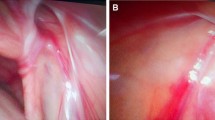Abstract
Background: Contralateral inguinal exploration in an infant with a symptomatic unilateral hernia is controversial. A patent processus vaginalis (PPV) may be found in up to 60% of term infants, and even in a greater number of preterm infants. However, only 10% to 30% of children will subsequently develop a contralateral hernia when only the symptomatic side is repaired. Standard contralateral laparoscopic inguinal exploration (CLIE) usually is performed through the ipsilateral groin with an angled scope or through the umbilicus with a 0° scope. A significant number of children have a peritoneal veil shrouding the internal ring. To enhance the accuracy of contralateral groin exploration, we have used a laparoscopic technique of directly visualizing the internal ring through a lateral abdominal approach.
Methods: From January 1993 through June 1997, we performed 141 CLIE on infants younger than 1 year of age with symptomatic unilateral inguinal hernia. After routine dissection on the symptomatic side, the sac was used to insufflate the abdominal cavity. A needle catheter was inserted on the contralateral abdominal wall and used to introduce a 1.2-mm scope. If a PPV was identified, the potential hernia was repaired using standard techniques.
Results: Of the 141 CLIEs performed on patients younger than 1 year of age, 39 (27.6%) were positive. There were no false-positives. In all, 42 CLIEs (29.7%) were performed on infants born at less than 36 weeks gestation, and 14 of these infants (33.3%) had a positive exploration. The patients were followed for 3 to 57 months. No complications resulted from the technique. One patient had a recurrence on the repaired side. No patients who had a negative CLIE subsequently developed a contralateral hernia.
Conclusions: The lateral abdominal approach for laparoscopic evaluation of the contralateral groin is safe and accurate, requiring no additional incisions. Longer follow-up is necessary to determine the true false-negative rate.
Similar content being viewed by others
Author information
Authors and Affiliations
Additional information
Received: 15 May 1998/Accepted: 15 June 1999
Rights and permissions
About this article
Cite this article
Owings, E.P., Georgeson, K.E. A new technique for laparoscopic exploration to find contralateral patent processus vaginalis. Surg Endosc 14, 114–116 (2000). https://doi.org/10.1007/s004649900078
Published:
Issue Date:
DOI: https://doi.org/10.1007/s004649900078




